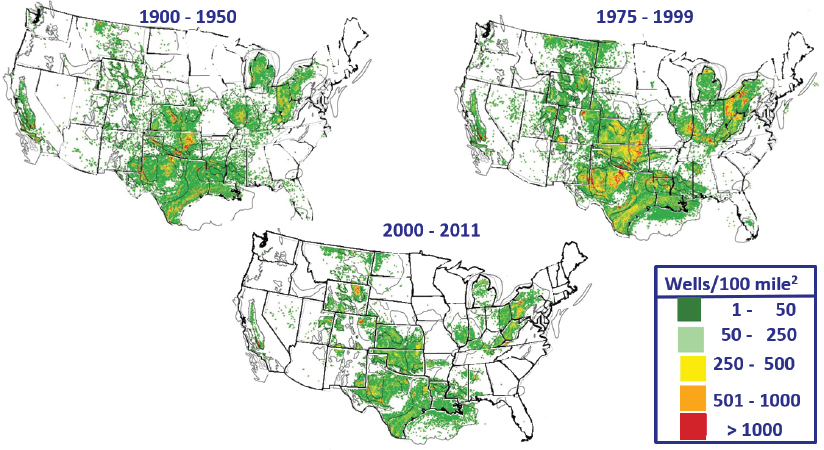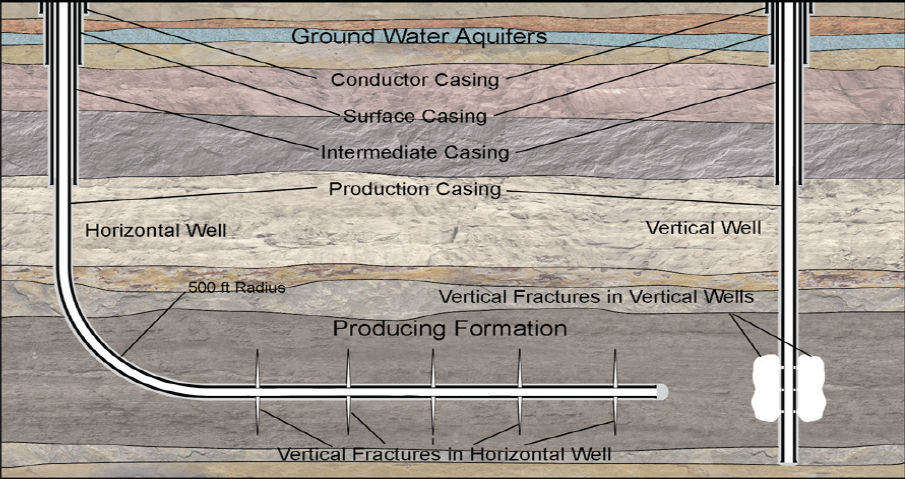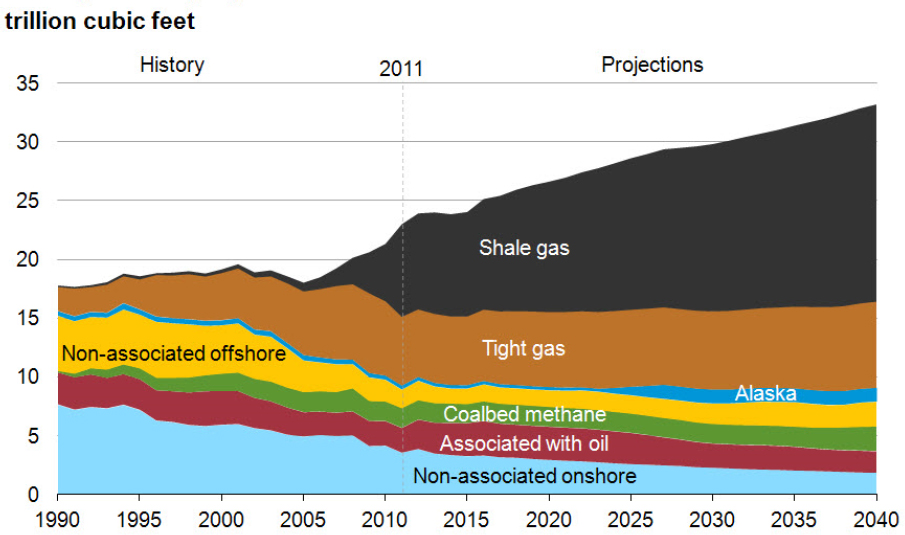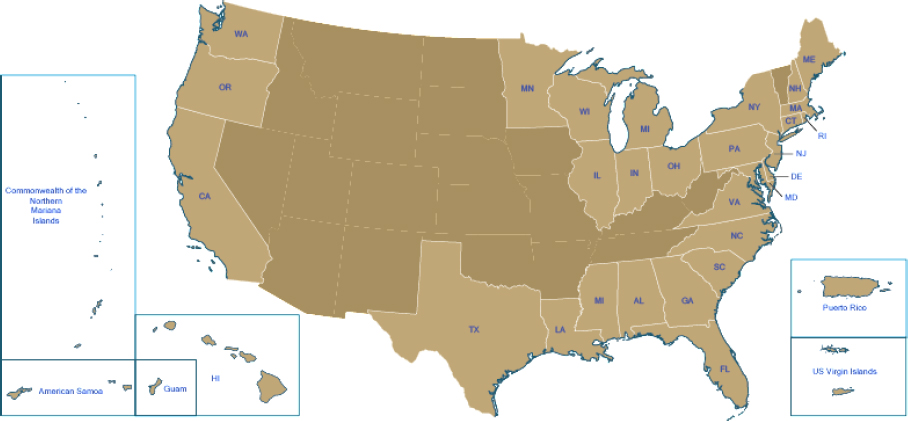3
Offshore Oil and Gas Development 101
The first panel of the workshop included three presentations that highlighted the common elements of offshore oil and gas development including the life cycle of offshore operations, the industry’s best practices and risk management strategies, and the state regulatory landscape. The panel and subsequent discussion between panelists and audience was moderated by Jill Lewandowski, Bureau of Ocean Energy Management.
PANEL PRESENTATIONS
Life Cycle for Offshore Development and the Offshore Footprint
Azra N. Tutuncu, Colorado School of Mines
Tutuncu opened her presentation with a historic overview of onshore and offshore exploration and production in the United States (see Figure 3.1). Since the first offshore operation out of sight of land began in 1947, offshore operations have expanded in the Gulf of Mexico, with additional activity off the coast of California. Production increased in the central Gulf throughout the 1970s, while migration toward the western Gulf (which has geological differences relative to the central Gulf) did not occur until after 2000. Tutuncu explained that much of today’s Gulf operations occur in ultra-deep water.
Tutuncu categorized the life cycle of an oil and gas field into five stages that take place over several decades. Exploration for viable hydrocarbon reservoirs occurs in the first 5 to 10 years during which many data are collected and, if an exploration well determines that a formation is carrying economically recoverable hydrocarbons, the reservoir is evaluated for production well placement. In the 15 to 30 years of production that follow, the field is developed, data about the reservoir continue to be collected, and the number of subsea wells tied back (with flow lines) to existing surface facilities may be increased to reach other parts of the reservoir. Decommissioning begins when production is no longer economically viable and at the end of this stage, the wells are ultimately reclaimed or plugged.

She explained that drilling, completion, production, and the length of the life cycle itself are influenced by the geology of the location. The geology of the Gulf of Mexico is particularly complex, given the large amount of salt that accumulated in 29 different depositional stages that began millions of years ago. This creates an especially challenging environment for exploration, drilling, completion, and production, according to Tutuncu. Prior to the development of advanced seismic processing techniques, geomechanical modeling, data integration, and better tomography efforts, it was difficult to collect clear images of some portions of the subsurface because of the salt, and thus difficult to obtain accurate information about sub-salt rock formations that might contain oil or gas. Additional challenges for drilling arise in the offshore environment as a result of lower fracture gradients and lower vertical stresses alongside higher pore pressures relative to the onshore environments, with higher pore pressures in the rock formations particularly as salt is approached. Advanced techniques such as managed pressure drilling or casing drilling can be used to overcome some of these challenges, Tutuncu explained.
Regarding asset evaluation, Tutuncu remarked that modeling how these formations will compact and how fluid pressure will change, in combination with real-time monitoring, can be useful in understanding the overall life cycle of production. She emphasized that offshore drilling allows for a smaller surface footprint with increased well productivity. Production continues to ramp up with the development of more wells and, when production stabilizes, advanced oil recovery techniques can then be used to extend maintenance of the reservoir pressure before the reservoir begins to decline in production. Tutuncu reiterated that a central objective in all offshore operations is to prevent or manage sand production and associated erosion within the well. High pressures and high temperatures in the offshore environment can make achieving this goal particularly difficult. Once production falls too low, she explained, the platform and field will be decommissioned—wells are flushed, plugged, and
cemented to secure the residual hydrocarbon reserves for future use. Tutuncu closed with a few comments about the progress in offshore deepwater technology: The first fixed offshore platform in greater than 1,000-foot water depth (Cognac well) was built in 1978, while the world’s deepest oil and gas project at around 9,500-foot water depth (Stones well) was built in 2016. She expects this arena will continue to evolve with the introduction of new technologies to confront the challenging deepwater environment.
Industry Risk Management—Industry Practices and Approaches for Managing Safety and Integrity of Well Stimulation Technologies
Benjamin Coco, American Petroleum Institute
Coco began his presentation with a brief history of the American Petroleum Institute (API). Founded in 1919 as a nonprofit national trade association, API represents all segments of the oil and natural gas industry and strives to have a completely transparent process in its development of industry standards. API published its first standard in 1925. By 1969, API also became active in public policy issues. He explained that the organization is accredited by the American National Standards Institute and has more than 660 member companies. API aims to improve safety, reliability, and equipment; reduce compliance and procurement costs; and offer a foundation for company standards. Although following API standards is a voluntary process, federal and state regulators cite API standards more than any other industry standards, according to Coco.
He defined three key terms that may be essential to understanding API’s standards:
- Risk management. Identification, assessment, and prioritization of risks followed by coordinated and economical application of resources to minimize, monitor, and control the probability and/or impact of unfortunate events or to maximize the realization of opportunities.
- Hydraulic fracturing. Well completion technology for the development of unconventional resources that creates a fracture network through which oil and gas can migrate to the wellbore.
- Consensus-based standards. Substantial agreement has been reached by directly and materially affected interests. (Not all standards fit this definition.)
Coco noted that attention to detail and best practices are crucial during well stimulation activities to avoid lasting negative impacts. He described well design and construction as featuring multiple layers of casing and cement. He mentioned four main components: conductor casing, surface casing, intermediate casing, and production casing (see Figure 3.2). Well-by-well design is determined by jurisdictional regulations and influenced by relevant standards.
Coco commented that prior to 2005, shale gas constituted only 4 percent of U.S. gas production; in 2013, it constituted more than 30 percent. He explained that domestic gas and oil production and reserves are now displacing gas and oil imports. He reiterated that onshore operations are quite different from those offshore in terms of accessibility, resources, logistics, and economics. He added that because of the increased volume of domestically produced natural gas (see Figure 3.3), an increase in production and a decrease in imports of natural gas
over time have taken place: U.S. exports will likely surpass U.S. consumption by 2020. Coco expects to see more growth in dry natural gas production, specifically, in the U.S. onshore environment and more opportunities in the offshore environment as well. He explained that reliance on natural gas and natural gas liquids will rise as industrial energy use grows and that there is no one-size-fits-all approach to managing associated risks.
Coco provided an overview of API documents specific to hydraulic fracturing that were developed in response to onshore activity.1 RP 100-1 contains best practices for well design as it relates to well integrity and fracture containment. RP 100-2 provides best practices for planning and operating a well that has been stimulated, including advice on managing environmental aspects during construction. RP 100-3 is a community engagement document that offers guidance on how industry can work with communities, address public concerns, and share mitigation strategies.2 Coco emphasized that standards documents do not contain “how to” guides, which can be found in academic texts instead. He added that the combination of standards documents and academic resources plays an important role in managing risk and planning operations.

___________________
1 API has more than 600 other types of standards relating to issues such as cement design, completion zones, and lease operations, indicating that many considerations exist when designing and executing a well. Available at http://www.api.org/products-and-services/standards/purchase#tab_catalog (accessed October 31, 2017).
2 Other organizations with relevant publications include the Center for Offshore Safety, the International Association of Drilling Contractors, the International Organization for Standardization, the International Organization of Oil & Gas Producers, the Offshore Operators Committee, and the Society of Petroleum Engineers.

The State Regulatory Landscape—State Responsibilities and Cooperation with Federal and Private Entities
Bradley Watson, Coastal States Organization
According to Watson, the Coastal States Organization (CSO)3 was created in 1970 and represents 34 coastal states/Great Lakes states/territories. The CSO has members appointed by the governors and the organization’s central mission is to increase collaboration among state, local, and federal agencies.
Watson explained that the Coastal Zone Management Act of 1972 (CZMA) recognizes a national interest in effective management, beneficial use, protection, and development of the coastal zone (boundaries defined differently in each state), which offers a natural, commercial, recreational, industrial, and aesthetic value. CZMA looks at economic development and environment concerns in balance; ensures that resources are available to people and industry; and reaffirms state sovereignty over coastlines while reinforcing a national interest. He remarked that CZMA created the following three entities: (1) National Coastal Zone Management Program, (2) National Estuarine Research Reserve System, and (3) Coastal and Estuarine Land Conservation Program.
The National Coastal Zone Management Program (see Figure 3.4) allows the states to take the lead when working with federal agencies to manage coastal resources and on issues of coastal development, public access, water quality, coastal hazards, and consistency of federal agency actions.4 Watson noted that federal agency actions that affect state coastal zones include such components as issuing licenses, implementing Outer Continental Shelf plans,
___________________
3 The website for the Coastal States Organization is www.coastalstates.org (accessed November 1, 2017).
4 Federal consistency refers to the notion that federal agency actions, in or outside the coastal zone, that affect any land or water use or natural resource of a state’s coastal zone must be consistent to the maximum extent possible with the enforceable policies of state CZMA programs (CZMA § 307 (16 U.S.C. § 1456)).

installing gas pipelines, and altering wetlands. Coastal effects of these actions may be direct, indirect, or cumulative, as well as positive or negative. If the agency identifies reasonably foreseeable effects, then a consistency determination will be submitted, according to Watson. An item under consistency review will be linked to a policy enforceable by the state that does not discriminate, assert jurisdiction over federal agencies or properties, and is not preempted by federal law, Watson continued. States then have the opportunity to respond to a consistency determination in one of four ways: concurrence, conditional concurrence, objection and appeal to the Secretary of Commerce, or, if no decision is made by the state, assumed concurrence. Historically, states have concurred with 93 to 95 percent of federal actions reviewed.
Watson emphasized that federal consistency helps avert disputes, streamline permits, increase collaboration, and decrease uncertainty and potential litigation in a timely fashion over activities in federal waters that affect state coastal zones. Ultimately, consistency allows for early consultation, cooperation, and coordination.
MODERATED DISCUSSION
Jill Lewandowski, Bureau of Ocean Energy Management
A participant asked about the potential for hydraulic fracturing and other unconventional technologies to be employed in ultra-deep water. Tutuncu explained that onshore, it takes an enormous amount of pressure to break a formation and start propagating a fracture. However, although the offshore environment has lower overburden stress, it also has lower fracture gradients than the onshore, which can make hydraulic fracturing easier in the offshore environment. She added that offshore formations are deposited differently from onshore shale formations—most offshore operations engage conventional deposits, though unconventional operations are possible in ultra-deep water. Tutuncu suggested that offshore unconventional operations may even be slightly easier than those onshore. Thus, although operations in ultra-deep water can be difficult from a well-integrity perspective, owing to the uncertainty in the
stress state, they are not difficult from a fracturing perspective. She reiterated that advanced technologies (e.g., advanced cementing, tubulars, and casing drilling) may be essential before drilling deeper in the offshore.
Another participant asked Watson about issues for unconventional hydrocarbons in the coastal zone regulatory environment. Watson emphasized that the issues are expansive and depend on the impact (e.g., harm to a species) to a state’s coastal zone from a specific action. Each state’s leadership has its own positions on the appropriateness of pursuing production after identifying an impact; however, the leadership is required to justify the impact to the Secretary of Commerce if the discussion proceeds to a higher level. Watson confirmed that although the specifics of conventional and unconventional hydrocarbon development vary, the process for identifying issues and addressing potential impacts are the same for both.
Because Alaska recently dropped its coastal zone management program, another participant noted that it deals with even more complicated decision-making issues. The participant voiced concerns about relying on standards in lieu of regulations in instances where standards can be difficult to enforce or may have gaps owing to a lack of consensus. While the participant acknowledged the good intentions of allowing the public to weigh in on standards, such an approach can add to the complexity of such a process. Coco responded that while some standards may present gaps in content or use non-consensus language, he asserted that it is better to offer some guidance rather than none. He added that it is the responsibility of a company to enforce a standard by incorporating and/or amending it as an official policy or by allowing the spirit of the standard to influence the company’s decision-making processes.
A participant asked Coco if API plans to publish specific guidance to address barriers in hydraulic fracturing. Coco reiterated that API does not issue prescriptive literature—that responsibility falls under the purview of the company instead. Because API’s standards are developed around the industry’s priority issues and the volunteers’ time and expertise, it is impossible for the organization to address every issue. However, Coco continued, API provides helpful risk-management tools. Another participant added that because there are myriad ways to solve a particular problem, it is best to avoid creating overly prescriptive standards that stifle innovation and limit opportunities for progress and safety. This participant encouraged workshop participants to attend API’s meetings to witness the rigor that goes into developing standards.
Given the complexity of offshore operations, a participant asked how coordination and communication are handled among the various units involved. Lewandowski responded that it depends on the statute, as there are differing oversight responsibilities, but the use of memoranda of understanding, standard operating procedures, and regular communication are indispensable. Despite this level of coordination, it remains challenging when different federal entities have different responsibilities. She noted that although the process is not perfect, it is continually improving with the use of communication spaces and streamlined opportunities as well as the avoidance of overregulation.
This page intentionally left blank.








